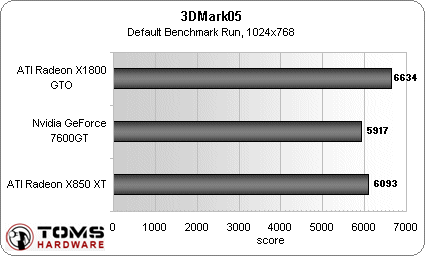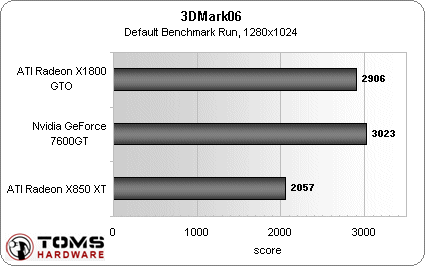Sub $200 PCI Express Graphics Card Showdown
Test System & Benchmarks
| System Hardware | |
|---|---|
| Processor(s) | AMD Athlon 64 3400+ (Venice)2.4 GHz (overclocked to 2.55 GHz), 512 kB L2 cache |
| Platform | ASrock 9393dual-SATA2 (socket 939)ULI 1695 chipset, BIOS v1.6 |
| RAM | PATRIOT EP1 x 1024 MB PC3500 (CL2.0-3-2-5) |
| Hard Drive | Western Digital WD1200JB120 GB, 7,200 RPM, 8 MB cache, UltraATA/100 |
| Networking | On-board 100 Mbit Ethernet |
| Graphics Card | ATI Radeon X1800 GTO (PCIe)Nvidia GeForce 7600 GT (PCIe)ATI Radeon X850 XT (PCIe)256 MB GDDR3 memory |
| Power Supply | Ultra X-Connect , ATX, 550 W |
| System Software & Drivers | |
| OS | Microsoft Windows XP Professional 5.10.2600, Service Pack 2 |
| DirectX Version | 9.0c (4.09.0000.0904) |
| Platform Driver | AMD Athlon 64 Processor Driver 1.2.2.0 |
| Graphics Driver | ATI Catalyst 6.6, Nvidia Forceware 91.31 |
First off, let's look at this article's benchmarking methodology a bit. This is a take-no-prisoners attempt to separate the men from the boys with these cards, so we're going to push them to the maximum with advanced settings and high resolutions. We're not interested in seeing, for example, one card deliver 74 frames per second while another delivers 88 frames per second... that difference is largely moot because in real life it's meaningless if your monitor's refresh rate is only 75 Hz anyway.
No, we want to find the edge of playability, to see which card (if any) can viably play games with a high level of eye candy. To our surprise, all of the cards did pretty well at resolutions and settings that in the past were reserved for only the highest-end video cards.
Benchmark Results
3DMark05
First let's start with the synthetic benchmarks. Although I don't put too much credence into synthetic tests, no comparison is complete without 3DMark scores. It's always interesting to see which card gets the most 3DMarks, and if those scores are consistent with real-world results.

3DMark 05 shows all three competitors as fairly close, with the Radeon X1800 GTO having a bit of a lead over the 7600 GT and X850 XT. 3DMark05 has been known to favor the X1800 architecture, though, so let's see if the trend continues with 3DMark06.
3DMark06

This is interesting: the X1800 GTO's advantage has vanished and it now performs neck and neck with the GeForce 7600 GT, which has a small lead. The Radeon X850 XT is notably behind the other competitors, which is due to its lack of support for Shader Model 3.0. Since 3DMark06 is a much more system-limited benchmark than 05, it's odd to see a thousand point spread in the scores.
That's it for the synthetics; I'm not going to analyze them to death. Let's see how they match up with real-life games. First on the list, one of the most demanding games available today: Elder Scrolls: Oblivion.
Stay on the Cutting Edge
Join the experts who read Tom's Hardware for the inside track on enthusiast PC tech news — and have for over 25 years. We'll send breaking news and in-depth reviews of CPUs, GPUs, AI, maker hardware and more straight to your inbox.
Current page: Test System & Benchmarks
Prev Page ATI Radeon X1800 GTO Next Page Elder Scrolls: OblivionMost Popular

